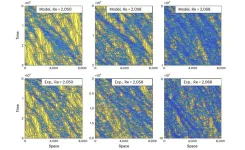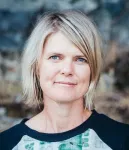(Press-News.org) In 1883 Osborne Reynolds injected ink into water in a short, clear pipe to observe its movement. His experiments showed that as the input water velocity increased, the flow went from laminar (smooth and predictable) to turbulent (unsteady and unpredictable) through the development of localized patches of turbulence, known today as “puffs.” His work helped launch the field of fluid mechanics, but, as experiments often do, it raised more questions. For example, why do these transitions between laminar and turbulent flows occur and how can the transitions be characterized quantitatively?
Although Reynolds was not able to find the answer, an international team of researchers, led by University of California San Diego Chancellor’s Distinguished Professor of Physics Nigel Goldenfeld and Björn Hof of the Institute of Science and Technology Austria have used statistical mechanics to solve this longstanding problem. Their work appears in Nature Physics.
One of the novelties of this work was that the team looked at the problem not only from the perspective of fluid mechanics, but also through statistical mechanics — the branch of physics that uses mathematics to describe the behavior of systems with a large number of particles. Usually this is applied to systems in equilibrium, but turbulence is not in equilibrium, because energy is constantly moving in and out of the fluid. However, building on their earlier work, the team showed that fluids move through a pipe in a non-equilibrium phase transition, known as directed percolation, at the transition point between laminar and turbulent flow. If “percolation” makes you think of your morning coffee, it provides a useful example here.
A storm in a coffee cup
When coffee is percolating, water moves through coffee grounds at a certain rate and flows downward in the direction of gravity. This flow is known as directed percolation. Too fast and the coffee is weak; too slow and the water backs ups and spills onto the counter. The best cup of coffee is one where the water flows at a rate slow enough to absorb the most flavor from the beans, but fast enough that it passes through the filter without backing up. And this best cup of coffee occurs at what is known as the directed percolation transition.
This may not seem relevant to fluid turbulence, but in earlier work, the team and other researchers in the field had evidence that the directed percolation transition had the same statistical properties as laminar-turbulent transitions.
“This problem has been around for nearly 150 years and required a bit of unconventional thinking to solve,” said Goldenfeld, who also holds appointments in the Jacobs School of Engineering and the Halicioğlu Data Science Institute. “And time. Some of the team members have been working on this aspect of the problem for well over a decade.”
Indeed, in 2016, the Hof group studied the laminar-turbulent transition experimentally in a circular geometry, at the same time that Goldenfeld and collaborators developed their theory of the laminar-turbulent transition.
Although the Hof group had demonstrated directed percolation in a circular geometry, what happens in an open geometry like a pipe remained unclear. Moreover, the experiments are impractical to do in a pipe geometry. While a circle is never-ending, the researchers estimated that to perform the same experiment in a pipe would require a length of 2.5 miles, and it would take centuries to collect the necessary data points.
To make progress, the team did two things. First, they used pressure sensors to observe the puffs in a pipe, and measured precisely how the puffs influenced each other’s motion. Inputting the data into a molecular dynamics computer simulation, they were able to show that statistically, near the laminar-turbulent transition, puff behavior was in excellent agreement with the directed percolation transition.
Second, they used statistical mechanics to mathematically predict the behavior of the puffs, using techniques from phase transition physics. This too validated the hypothesis of a directed percolation transition.
Through this research, the team also discovered something unexpected from both the detailed experiments and the statistical mechanical theory: like cars on the freeway in rush hour, puffs are prone to traffic jams. If a puff fills the width of a pipe, nothing can move past it, which means other puffs may build up behind it. And just as you might wonder why traffic jams occur and why they clear up with no identifiable cause, puff jams can also form and dissipate on their own, in a way that statistical mechanics describes. Puff jams tend to “melt” at the critical transition point from laminar to turbulent flow, giving way to the special statistical behavior of the directed percolation transition.
Goldenfeld commented: “This work not only closes one chapter on the laminar-turbulent transition in pipes, but shows how insights from different scientific disciplines can unexpectedly illuminate a difficult problem. Without a statistical mechanics perspective, understanding this quintessential fluid mechanics phenomenon would have been impossible.”
This research was funded in part by the Simons Foundation (662985 and 662960) and the Ministry of Science and Technology, Taiwan (MOST 109-2112-M-001-017-MY3 and MOST 111-2112-M-001-027-MY3).
Full list of authors: Nigel Goldenfeld (UC San Diego), Björn Hof and Vasudevan Mukund (both Institute of Science and Technology Austria), Hong-Yan Shih (Institute of Physics, Academia Sinica (Taiwan)), Gaute Linga (the Njord Center, University of Oslo), Joachim Mathiesen (Niels Bohr Institute, University of Copenhagen), and Grégoire Lemoult (Université Le Havre Normandie).
END
The unexpected connection between brewing coffee and understanding turbulence
Unconventional use of statistical mechanics sheds light on how turbulence occurs
2024-06-03
ELSE PRESS RELEASES FROM THIS DATE:
Researchers call for return of Sumas Lake following devastating 2021 floods
2024-06-03
A new proposal has emerged in response to the November 2021 floods that swept Sumas Prairie in the Fraser Valley, British Columbia, causing mass evacuations and millions in damages.
Instead of rebuilding the dykes to manage water flows and prevent future floods, scientists at UBC, along with members of the Sumas First Nation and other research partners, suggest an alternative: let Sumas Lake, which was drained in the early 1920s and converted into the farmland known as Sumas Prairie, return to its natural state.
This ...
Transition-metal-free zeolite catalyst for direct conversion of methane to methanol
2024-06-03
In light of the waste-to-wealth movement, technology for converting greenhouse gases into value-added materials has gained significant attention in recent years. One such technology is the catalytic conversion of methane into methanol, a widely used industrial solvent and raw material for chemical synthesis. The industrial process for conversion of methane to methanol is extremely energy and resource-intensive. In the past decade, scientists have developed several catalyst systems that can enable direct oxidation of methane to methanol. However, most of them are based on ...
Retrospective study based on electronic health records finds popular diabetes and weight-loss drugs associated with reduction in incidence and recurrence of alcohol-use disorder by at least half
2024-06-03
CLEVELAND—A new study by researchers at the Case Western Reserve University School of Medicine reveals that the popular diabetes and weight-loss drugs Wegovy and Ozempic are linked to reduced incidence and recurrence of alcohol abuse or dependence.
The team’s findings, recently published in the journal Nature Communications, may suggest a possible new treatment for excessive alcohol use—including alcohol-use disorder (AUD), a health condition that causes about 178,000 deaths in the United States each year, according to the Centers for Disease Control.
To date, the U.S. Food and Drug Administration ...
Enhancing nanofibrous acoustic energy harvesters with artificial intelligence
2024-06-03
(LOS ANGELES) June 3, 2024 – Scientists at the Terasaki Institute for Biomedical Innovation (TIBI), have employed artificial intelligence techniques to improve the design and production of nanofibers used in wearable nanofiber acoustic energy harvesters (NAEH). These acoustic devices capture sound energy from the environment and convert it into electrical energy, which can then be applied in useful devices, such as hearing aids.
Many efforts have been made to capture naturally occurring and abundant energy sources ...
Research pioneer and paradigm-shifting thought leader for breast cancer precision medicine to receive the 2024 Szent-Györgyi Prize for Progress in Cancer Research
2024-06-03
June 3, 2024 (Rockville, MD)
The National Foundation for Cancer Research (NFCR) is announcing that the blue-ribbon selection committee, composed of world-renowned research leaders and visionaries, has awarded the 2024 Szent-Györgyi Prize for Progress in Cancer Research to Dennis J. Slamon, M.D., Ph. D. from UCLA Health for his groundbreaking research discoveries that helped to shape the field of precision medicine for breast cancer patients.
The cancer research community will celebrate Dr. ...
Assessing the environmental and downstream human health impacts of decentralizing cancer care
2024-06-03
About The Study: This cohort study found that using decentralization through telemedicine and local care may substantially reduce cancer care’s greenhouse gas emissions; this corresponds to small reductions in human mortality.
Corresponding Author: To contact the corresponding author, Gregory A. Abel, M.D., M.P.H., email gregory_abel@dfci.harvard.edu.
To access the embargoed study: Visit our For The Media website at this link https://media.jamanetwork.com/
(doi:10.1001/jamaoncol.2024.2744)
Editor’s Note: Please see the article for additional information, including other authors, author contributions and affiliations, ...
Telehealth can significantly reduce greenhouse gas emissions associated with cancer care, study finds
2024-06-03
BOSTON – Telemedicine visits for cancer care may not only be more convenient and easier to schedule than in-person appointments, they're also better for the planet, new research by Dana-Farber Cancer Institute scientists shows.
Based on an analysis of data from a regional cancer center, the researchers calculate that, nationwide, cancer care that utilizes telehealth and local care would generate 33.1% less greenhouse gas emissions than the traditional model of in-person care, primarily because of reduced travel to medical appointments. ...
Brain waves shape the words we hear
2024-06-03
The timing of our brain waves shapes how we perceive our environment. We are more likely to perceive events when their timing coincides with the timing of relevant brain waves. Lead scientist Sanne ten Oever and her co-authors set out to determine whether neural timing also shapes speech perception. Is the probability of speech sounds or words encoded in our brain waves and is this information used to recognise words?
The team first created ambiguous stimuli for both sounds and words. For instance, the initial sounds in da and ga differ in probability: ‘d’ is more common than ‘g’. The Dutch words dat “that” and gat “hole” ...
Geographic distribution of clinical trials for advanced-stage cancer
2024-06-03
About The Study: This quality improvement analysis of clinical trials for metastatic breast, lung, colon, pancreatic, and prostate cancers found that a large proportion of the U.S. population lived within 30 miles of a clinical trial site. This finding suggests that while many clinical trials are available, they are not evenly distributed across the country and may not be accessible to all individuals, particularly racial and ethnic minority individuals. This disparity in access to clinical trials raises important questions about equity and fairness in the distribution of health care resources and opportunities ...
PSU secures $1 million grant for high-performance computing cluster across Oregon
2024-06-03
Portland State will power up a new high-performance computing cluster that will give researchers at universities and colleges across Oregon the ability to advance computing-intensive research projects by processing large datasets and performing complex computations in a fraction of the time — thanks to a nearly $1 million grant from the National Science Foundation’s Campus Cyberinfrastructure program.
The Oregon Regional Computing Accelerator (Orca) aims to provide free-of-cost computing resources and cyberinfrastructure ...
LAST 30 PRESS RELEASES:
Heart-brain connection: international study reveals the role of the vagus nerve in keeping the heart young
Researchers identify Rb1 as a predictive biomarker for a new therapeutic strategy in some breast cancers
Survey reveals ethical gaps slowing AI adoption in pediatric surgery
Stimulant ADHD medications work differently than thought
AI overestimates how smart people are, according to HSE economists
HSE researchers create genome-wide map of quadruplexes
Scientists boost cell "powerhouses" to burn more calories
Automatic label checking: The missing step in making reliable medical AI
Low daily alcohol intake linked to 50% heightened mouth cancer risk in India
American Meteorological Society announces Rick Spinrad as 2026 President-Elect
Biomass-based carbon capture spotlighted in newly released global climate webinar recording
Illuminating invisible nano pollutants: advanced bioimaging tracks the full journey of emerging nanoscale contaminants in living systems
How does age affect recovery from spinal cord injury?
Novel AI tool offers prognosis for patients with head and neck cancer
Fathers’ microplastic exposure tied to their children’s metabolic problems
Research validates laboratory model for studying high-grade serous ovarian cancer
SIR 2026 delivers transformative breakthroughs in minimally invasive medicine to improve patient care
Stem Cell Reports most downloaded papers of 2025 highlight the breadth and impact of stem cell research
Oxford-led study estimates NHS spends around 3% of its primary and secondary care budget on the health impacts of heat and cold in England
A researcher’s long quest leads to a smart composite breakthrough
Urban wild bees act as “microbial sensors” of city health.
New study finds where you live affects recovery after a hip fracture
Forecasting the impact of fully automated vehicle adoption on US road traffic injuries
Alcohol-related hospitalizations from 2016 to 2022
Semaglutide and hospitalizations in patients with obesity and established cardiovascular disease
Researchers ‘listen in’ to embryo-mother interactions during implantation using a culture system replicating the womb lining
How changing your diet could help save the world
How to make AI truly scalable and reliable for real-time traffic assignment?
Beyond fragmented markets: A new framework for efficient and stable ride-pooling
Can shape priors make road perception more reliable for autonomous driving?
[Press-News.org] The unexpected connection between brewing coffee and understanding turbulenceUnconventional use of statistical mechanics sheds light on how turbulence occurs






